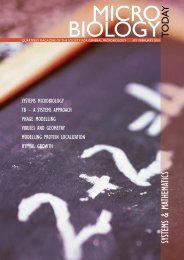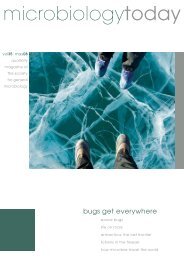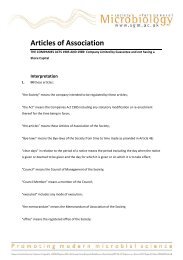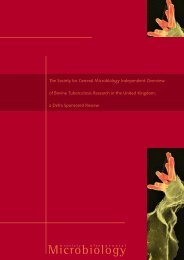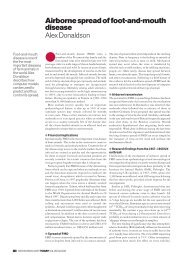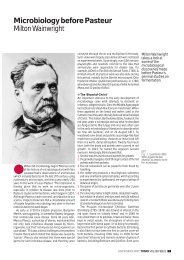Download - Society for General Microbiology
Download - Society for General Microbiology
Download - Society for General Microbiology
You also want an ePaper? Increase the reach of your titles
YUMPU automatically turns print PDFs into web optimized ePapers that Google loves.
Ancient<br />
fungal<br />
farmers<br />
of the<br />
insect<br />
world<br />
Not only humans practise agriculture.<br />
As Garret Suen and Cameron R. Currie<br />
describe, ants have amazing systems of<br />
growing fungal crops in their ‘gardens’ too.<br />
b A worker of the leaf-cutting ant Acromyrmex octospinosus tends to her fungus garden. These<br />
ants grow bacteria on their body and use the antibiotics the bacteria produce to protect their<br />
gardens against infection from invading pathogens. Heidi Horn<br />
Take a stroll through a rain <strong>for</strong>est in South America<br />
and you might find yourself walking in a river, not<br />
of water, but of leaves. Leaf-cutter ants swarm in the<br />
underbrush, carrying their precious cargo back to<br />
their nest with an apparent single-minded determination.<br />
This conspicuous behaviour has made<br />
these ants one of the most dominant herbivores in the Neotropics,<br />
and one of the most successful social insects in nature.<br />
A closer look at the ants reveals that they are ancient farmers,<br />
having developed the secret of agriculture over 50 million<br />
years ago. Using their freshly-cut leaves, they incorporate<br />
them into gardens where they grow a specialized fungus<br />
that they consume <strong>for</strong> food. This relationship between ant<br />
and fungus has been described as a breakthrough in animal<br />
behaviour, and parallels the practice of sustainable agriculture<br />
in humans, arguably the most important development in<br />
human civilization that, in our opinion, resulted in the<br />
dominance of humans on planet Earth.<br />
Leaf-cutting ants are the most highly-derived group of ants<br />
that practice fungus growing. A total of four other fungusgrowing<br />
ant agricultural systems have been described,<br />
spanning over 200 different species of ants, each based on<br />
the type of fungus grown and the material incorporated into<br />
their gardens. The vast majority of fungus-growing ants do<br />
not cut leaves, but instead collect fruit,<br />
leaf litter and decomposing organic<br />
material, such as caterpillar dung, to<br />
grow their fungus.<br />
Fungus-growers also have diverse<br />
colony sizes, with some species containing<br />
only a few hundred workers,<br />
while many leaf-cutting ant species<br />
can contain upwards of 5 million. All<br />
species, however, follow the same life<br />
cycle. Organic material is brought into<br />
the colony by <strong>for</strong>agers and is then<br />
processed to <strong>for</strong>m a garden matrix<br />
where the fungus grows. New material<br />
is continuously incorporated into the<br />
gardens in order to propagate the<br />
fungus, and old material is removed<br />
by the ants and placed in special refuse<br />
dumps away from the colony. In many<br />
groups of fungus-growing ants, the<br />
fungus produces specialized packets<br />
of nutrients called gongylidia that the<br />
ants eat and feed to their developing<br />
brood. At the start of the rainy season,<br />
the colony produces male and female<br />
winged reproductives called aletes,<br />
which mate in a spectacular display<br />
of flying ants. The newly-mated queens<br />
then go on to found new colonies.<br />
Young queens transport a small piece<br />
of the fungus garden in a special organ<br />
known as an infrabuccal pocket when<br />
they leave the nest <strong>for</strong> their mating<br />
flights, and thus ensure that they can<br />
successfully start a fungus garden in<br />
the new colony.<br />
Garden microbiology<br />
Until about a decade and a half<br />
ago, research on fungus-growing ants<br />
focused primarily on the ants and their<br />
<strong>for</strong>aging behaviour. It wasn’t until the<br />
early 1990s that this focus shifted to<br />
the fungus gardens and their associated<br />
microbial communities. Since the<br />
ant gardens are maintained in soil<br />
chambers, they are routinely exposed<br />
to a number of potential pathogens<br />
172 microbiology today nov 08 microbiology today nov 08 173



